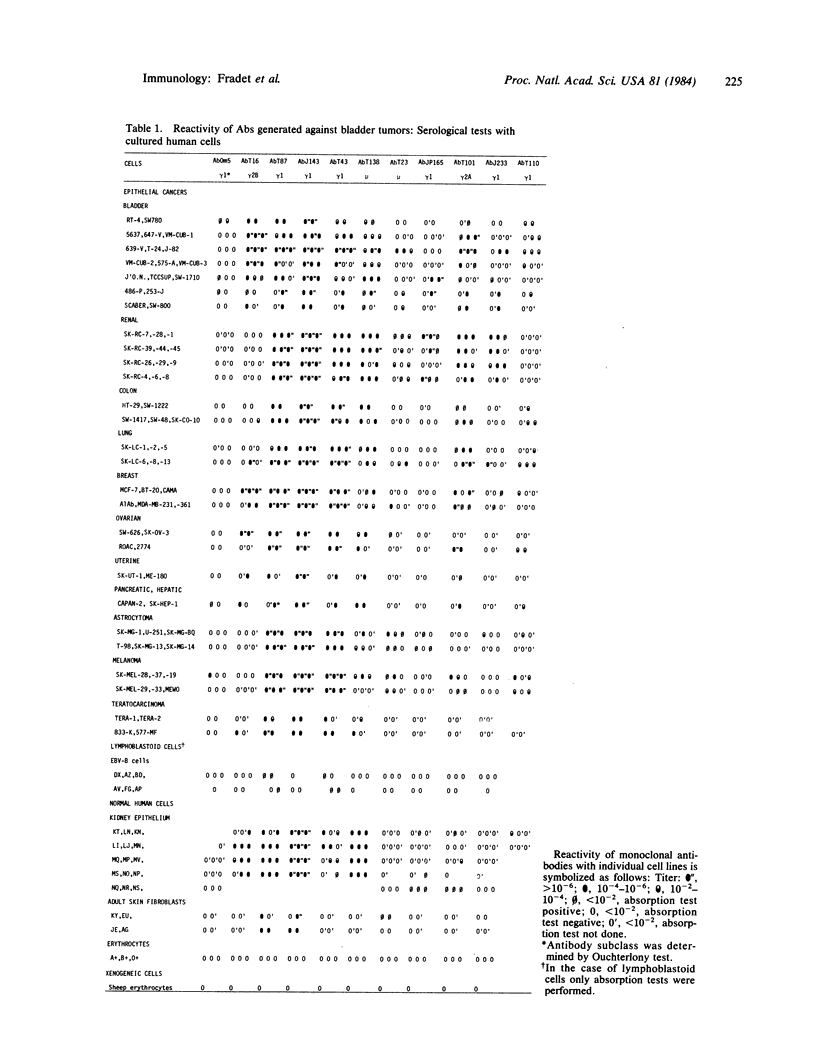Abstract
Mouse monoclonal antibodies were obtained by immunization with cultured human bladder cancer or lysates of bladder papilloma. They identify 11 distinct antigenic systems as defined by serological analysis of cultured cells and studies of antigen distribution in normal and neoplastic tissues. The most restricted of these antigens, Om5, defines a subset of bladder tumors. Om5 is not detected in normal bladder urothelium or in any other normal or malignant tissue. T101 and JP165 are also subset markers for bladder cancer that are not detected in normal tissues. T16, T43, T87, and J143 (antigens represented on many cultured cells) are found in specific areas of the normal urinary tract and in a distinctive range of other normal and malignant cell types--e.g., T16 expression in pluristratified epithelium of skin, exocervix, and esophagus. T138 antigen is also a common feature of cultured cell lines, but its expression in sections of normal tissues is restricted to endothelial cells. In contrast, T110 is poorly represented on cultured cells but can be detected in culture supernatants. Localization of T110 in normal tissues showed that it is a component of the extracellular matrix. All determinants detected by this series of antibodies are heat labile and not related to A, B, H, I, Lewis blood group antigens. Six of the antibodies immunoprecipitated glycoproteins from radiolabeled cell lysates: AbT16 (Mrs 48,000 and 42,000), AbT87 (Mr 60,000), AbT43 (Mr 85,000), AbJ143 (Mr 140,000, 120,000, 60,000), AbT43 (Mr 85,000), AbJ143 (Mr 140,000, 120,000, and 30,000), and AbT110 (Mr 240,000).
Full text
PDF




Images in this article
Selected References
These references are in PubMed. This may not be the complete list of references from this article.
- Anger B. R., Lloyd K. O., Oettgen H. F., Old L. J. Mouse monoclonal IgM antibody against human lung cancer line SK-LC-3 with specificity for H(O) blood group antigen. Hybridoma. 1982;1(2):139–147. doi: 10.1089/hyb.1.1982.1.139. [DOI] [PubMed] [Google Scholar]
- Cairncross J. G., Mattes M. J., Beresford H. R., Albino A. P., Houghton A. N., Lloyd K. O., Old L. J. Cell surface antigens of human astrocytoma defined by mouse monoclonal antibodies: identification of astrocytoma subsets. Proc Natl Acad Sci U S A. 1982 Sep;79(18):5641–5645. doi: 10.1073/pnas.79.18.5641. [DOI] [PMC free article] [PubMed] [Google Scholar]
- Carey T. E., Takahashi T., Resnick L. A., Oettgen H. F., Old L. J. Cell surface antigens of human malignant melanoma: mixed hemadsorption assays for humoral immunity to cultured autologous melanoma cells. Proc Natl Acad Sci U S A. 1976 Sep;73(9):3278–3282. doi: 10.1073/pnas.73.9.3278. [DOI] [PMC free article] [PubMed] [Google Scholar]
- Cote R. J., Morrissey D. M., Houghton A. N., Beattie E. J., Jr, Oettgen H. F., Old L. J. Generation of human monoclonal antibodies reactive with cellular antigens. Proc Natl Acad Sci U S A. 1983 Apr;80(7):2026–2030. doi: 10.1073/pnas.80.7.2026. [DOI] [PMC free article] [PubMed] [Google Scholar]
- Dippold W. G., Lloyd K. O., Li L. T., Ikeda H., Oettgen H. F., Old L. J. Cell surface antigens of human malignant melanoma: definition of six antigenic systems with mouse monoclonal antibodies. Proc Natl Acad Sci U S A. 1980 Oct;77(10):6114–6118. doi: 10.1073/pnas.77.10.6114. [DOI] [PMC free article] [PubMed] [Google Scholar]
- Foon K. A., Schroff R. W., Gale R. P. Surface markers on leukemia and lymphoma cells: recent advances. Blood. 1982 Jul;60(1):1–19. [PubMed] [Google Scholar]
- Houghton A. N., Eisinger M., Albino A. P., Cairncross J. G., Old L. J. Surface antigens of melanocytes and melanomas. Markers of melanocyte differentiation and melanoma subsets. J Exp Med. 1982 Dec 1;156(6):1755–1766. doi: 10.1084/jem.156.6.1755. [DOI] [PMC free article] [PubMed] [Google Scholar]
- Lloyd K. O., Larson G., Strömberg N., Thurin J., Karlsson K. A. Mouse monoclonal antibody F-3 recognizes the difucosyl type-2 blood group structure. Immunogenetics. 1983;17(5):537–541. doi: 10.1007/BF00696877. [DOI] [PubMed] [Google Scholar]
- Mattes M. J., Cairncross J. G., Old L. J., Lloyd K. O. Monoclonal antibodies to three widely distributed human cell surface antigens. Hybridoma. 1983;2(3):253–264. doi: 10.1089/hyb.1983.2.253. [DOI] [PubMed] [Google Scholar]
- Mattes M. J., Tanimoto M., Pollack M. S., Maurer D. H. Preparing monolayers of non-adherent mammalian cells. J Immunol Methods. 1983 Jul 15;61(2):145–150. doi: 10.1016/0022-1759(83)90156-4. [DOI] [PubMed] [Google Scholar]
- Ueda R., Ogata S., Morrissey D. M., Finstad C. L., Szkudlarek J., Whitmore W. F., Oettgen H. F., Lloyd K. O., Old L. J. Cell surface antigens of human renal cancer defined by mouse monoclonal antibodies: identification of tissue-specific kidney glycoproteins. Proc Natl Acad Sci U S A. 1981 Aug;78(8):5122–5126. doi: 10.1073/pnas.78.8.5122. [DOI] [PMC free article] [PubMed] [Google Scholar]
- Ueda R., Shiku H., Pfreundschuh M., Takahashi T., Li L. T., Whitmore W. F., Oettgen H. F., Old L. J. Cell surface antigens of human renal cancer defined by autologous typing. J Exp Med. 1979 Sep 19;150(3):564–579. doi: 10.1084/jem.150.3.564. [DOI] [PMC free article] [PubMed] [Google Scholar]



